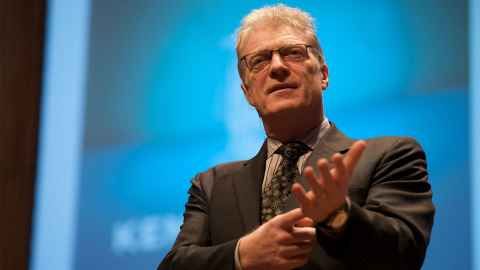A loss for education
24 August 2020
Opinion: Peter O’Connor pays tribute to the late Sir Ken Robinson who championed the idea that schools might be better places if built on arts and creativity.

Sir Ken Robinson was that rare academic who could speak beyond the narrow confines of the university in a way that excited and energised people across the planet. He was driven by a mission to rethink and improve schooling. He was the most gifted eloquent and popular philosopher of this generation.
His TEDX talk in 2006 on how schools kill creativity remains one of the most watched talks of all times with over 65 million views. The truth of his claim that schools deliberately snuff out the vital heart of our humanity resonated deeply with parents who saw it happening to their own children and then remembered their own stultifying education. For teachers trapped in systems that punish creativity, his words and most particularly his powerful stories reminded them of why they entered the profession. He ignited for millions a passion to move beyond the tired meta data driven approaches that have constrained teaching to a rather dull technical skill.
Sir Ken’s death this weekend aged 70, after a short battle with cancer, was a shock to the many thousands of teacher and principals across the world who were inspired by his disarmingly simple idea that schools might be better and more human places if the joy and wonder of the arts and creativity found their way into the dismal factory-like atmosphere of too many of our schools.
The British educationalist never promoted creativity over disciplinary knowledge. He was after all an artist, a theatre maker and drama teacher himself so he knew that creativity is not about wafting around the world freely expressing yourself. He knew that the arts are highly disciplined and disciplining and that success in the arts means mastering the skills, knowledge and understanding of artistic media.
Sir Ken’s death was premature and those of us who are arts educators feel bereft. Perhaps because the vision was so clear, so wittily and poetically expressed we felt there was a chance that policy makers might pick up his challenges, understand how the arts might make the difference we all seek in schools.
Nor did he think that a focus on the arts meant that schools should lose sight of the importance of literacy and numeracy as base skills for employment. Rather he understood that the arts as ways of learning were powerful motivators and tools for developing success across the curriculum. We know drama helps children read with a deeper capacity for inferential understanding, that dance helps children understand the patterns and rhythms of numbers. The visual arts help us understand spatial relationships so we might better understand personal relationships, and music salves the soul in a way that nothing else can.
What Sir Ken tapped into with his legion of followers was that the balance in schools was wrong, that it wasn’t about attending to the creative side at the expense of other things of importance in schools. It was about addressing the punishing regime of testing, of league tables, of the nonsense that still permeates much of schooling policy. Sir Ken never talked about the creative side of things. For him, creativity was the inside of us, the piece that makes us fully human.
Sir Ken’s death was premature and those of us who are arts educators feel bereft. Perhaps because the vision was so clear, so wittily and poetically expressed we felt there was a chance that policy makers might pick up his challenges, understand how the arts might make the difference we all seek in schools.
The grief we feel though, perhaps beyond the loss of this extraordinarily gifted communicator, is that despite the eloquence and inspiration, Sir Ken’s work has never been adopted beyond individual classrooms and schools. Policy makers and governments of many hues have embraced his ideas, celebrated the poetry and laughed at his wondrous stories but never put them into practice.
The current ministers of education ran more than 20 different reviews of education on schooling, without any reference or thought given to the power of the arts and creativity to truly make the difference so desperately needed. The arts and creativity languish in our schools without any change to that in sight. The arts, not as a curriculum area, but as a language system, as a means to both think and express our thinking still has no currency in policy on schooling despite the overwhelming evidence that the arts make a significant difference to literacy, to well-being, to numeracy and is a powerful way to teach history and science.
Earlier this year, as we came out of lockdown and children returned to schools, the resource created at the University of Auckland Te Rito Toi used the arts as a way for schools to focus on wellbeing. Within a month more than 250,000 downloads of the site reinforced the urgent desire that teachers have to see the joy and wonder of the arts have a central place in our schools. It was the biggest use of the arts in schools in over a generation.
Sir Ken’s vision deserves protection in practical implementation. Resuscitating the arts in New Zealand schools is about breathing life back into learning.
Peter O’Connor is Professor of Education at the University of Auckland.
This article reflects the opinion of the authors and not necessarily the views of the University of Auckland.
Used with permission from Newsroom A loss for education 24 August 2020.
Media queries
Alison Sims | Research Communications Editor
DDI 09 923 4953
Mob 021 249 0089
Email alison.sims@auckland.ac.nz